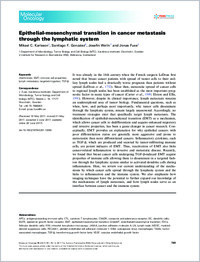Epithelial-mesenchymal transition in cancer metastasis through the lymphatic syste
- Karlsson, Mikael C. Department of Microbiology, Tumor Biology and Cell Biology (MTC), Karolinska Institutet, Stockholm, Sweden
- Gonzalez, Santiago F. Institute for Research in Biomedicine (IRB), Faculty of Biomedical Sciences, Università della Svizzera italiana, Switzerland
- Welin, Josefin Department of Microbiology, Tumor Biology and Cell Biology (MTC), Karolinska Institutet, Stockholm, Sweden
- Fuxe, Jonas Department of Microbiology, Tumor Biology and Cell Biology (MTC), Karolinska Institutet, Stockholm, Sweden
-
26.06.2017
Published in:
- Molecular oncology. - 2017, vol. 11, p. 781–791
English
It was already in the 18th century when the French surgeon LeDran first noted that breast cancer patients with spread of tumor cells to their axillary lymph nodes had a drastically worse prognosis than patients without spread (LeDran et al., ). Since then, metastatic spread of cancer cells to regional lymph nodes has been established as the most important prognostic factor in many types of cancer (Carter et al., ; Elston and Ellis, ). However, despite its clinical importance, lymph metastasis remains an underexplored area of tumor biology. Fundamental questions, such as when, how, and perhaps most importantly, why tumor cells disseminate through the lymphatic system, remain largely unanswered. Accordingly, no treatment strategies exist that specifically target lymph metastasis. The identification of epithelial-mesenchymal transition (EMT) as a mechanism, which allows cancer cells to dedifferentiate and acquire enhanced migratory and invasive properties, has been a game changer in cancer research. Conceptually, EMT provides an explanation for why epithelial cancers with poor differentiation status are generally more aggressive and prone to metastasize than more differentiated cancers. Inflammatory cytokines, such as TGF-β, which are produced and secreted by tumor-infiltrating immune cells, are potent inducers of EMT. Thus, reactivation of EMT also links cancer-related inflammation to invasive and metastatic disease. Recently, we found that breast cancer cells undergoing TGF-β- induced EMT acquire properties of immune cells allowing them to disseminate in a targeted fashion through the lymphatic system similar to activated dendritic cells during inflammation. Here, we review our current understanding of the mechanisms by which cancer cells spread through the lymphatic system and the links to inflammation and the immune system. We also emphasize how imaging techniques have the potential to further expand our knowledge of the mechanisms of lymph metastasis, and how lymph nodes serve as an interface between cancer and the immune system.
- Language
-
- English
- Classification
- Medicine
- License
- Open access status
- gold
- Identifiers
-
- RERO DOC 327040
- DOI 10.1002/1878-0261.12092
- ARK ark:/12658/srd1318998
- Persistent URL
- https://n2t.net/ark:/12658/srd1318998
Statistics
Document views: 214
File downloads:
- Texte intégral: 452
